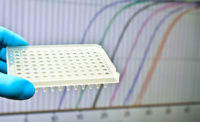Advancements in rapid-testing technology




The sooner one finds out a food product meets quality and safety requirements, the sooner it can be sold. That is why scientists are working to advance rapid testing, so companies easily can decide what to do with product to prevent foodborne illness.
Examining rapid testing in the beef industry today sheds light upon how complex the detection of microorganisms can be. For example, beef processors, who are generating or receiving boneless beef trim to grind into ground beef, are testing every 2,000-pound combo. It’s an enormous and dynamic type of process, explains Randy Phebus, a professor of food safety and defense in the Department of Animal Sciences and Industry at Kansas State University.
“Chilled inventory capacity is super-restrained in some of these companies, and it’s also a very perishable product,” he explains. “You just have to be able to release product after a negative screen quickly so that you are not building up such a huge amount of inventory.”
Phebus and Rod Moxley, a professor at the School of Veterinary Medicine and Biomedical Sciences at the University of Nebraska-Lincoln, are leaders on a $25 million, coordinated agricultural program (CAP) grant from the U.S. Department of Agriculture (USDA), with one of the grant’s primary objectives focused on detection methods for Shiga toxin-producing E. coli (STEC) in the beef industry.
The USDA’s Food Safety and Inspection Service (FSIS) has specific protocols for its regulatory support laboratories to follow to detect organisms that are extensive. Typically it may take four days or more to complete the entire procedure. The first day involves broth culture, and on Day Two, screening tests are done. If these tests yield positive results, it is called a “potential positive,” and the product is held until further testing can be completed. If upon additional testing, usually on Day Three, positive results are again obtained, this is called a “presumptive positive.” More laboratory work then is required to isolate the organism and confirm its identity and virulence traits.
“Time is extremely important,” Moxley says. “When you have product in the plant that has been screened for these pathogens and has test results that qualify as a potential or presumptive positive — meaning that the test results indicate the pathogen may be present, but more testing is needed — then that product is just setting there, and this creates problems.”
In reality, if a company gets a presumptive positive test result, in most cases, they are not holding on to the product for another one or two days of confirmation tests.
“They basically send it to cooking operations where, through a validated process, you can kill any potential pathogens by cooking,” Phebus says. “That really is a devaluation of raw materials, so you don’t want to do that if you don’t have to.”
Rapid testing advances
In general, current rapid-testing developments are being made in two main areas: DNA-based and immunological-based methods. Most DNA-based methods use a technology known as polymerase chain reaction (PCR). PCR detects specific sequences of DNA indicative of target pathogens as, for example, bacteria. PCR has been further improved and developed to include real-time PCR. Real-time PCR is a type of rapid testing that detects relatively quickly a DNA-sequence target and also may provide some data on the quantity of the microorganism, Moxley explains. Real-time PCR test results are possible in an hour and half, not including upfront sample preparations and sample enrichment.
“It has an advantage of being rapid, specific and quantitative to some extent,” he says.
Immunologically based testing methods use specific antigen-antibody reactions to screen sample enrichments for a target pathogen and/or test pure culture isolates as part of identification and confirmation steps. CAP grant scientists are in the process of developing monoclonal antibodies against the six STEC serotypes currently defined as adulterants in beef. Most immunologic based methods used today for E. coliO-antigen detection employ polyclonal antibodies, which are not as specific as monoclonal antibodies.
“These would be very specific antibodies against the O group,” Moxley says.
An example of an immunologic based testing system would be lateral flow devices.
“Some lateral flow devices have been developed for E. coli O157:H7 a number of years ago that resulted from the development of monoclonal antibodies,” Moxley says. “Now that we would be developing these others, we will try to develop lateral flow devices for these other O groups.”
Scientists also involved in the CAP grant are developing other immunologically based methods that will come from the grant’s monoclonal antibody development called a wave guide based biosensor, a next-generation assay.
“This would be a way to detect the proteins that would be present like Shiga toxin in a sample,” Moxley explains. “It would also detect the O group that is on the surface of the bacteria.”
One of the advantages to immunological-based diffusion-type assays is that they are lower cost,
Phebus says.
“You don’t have to have specialized equipment,” he explains. “It’s basically like a home pregnancy test. People, even small companies, can do this very easily, and you don’t have to have all the sophisticated, expensive equipment that PCR might require. There is never a one-size assay that fits all analytical needs. It is dictated by what type of laboratory, what type of technical expertise and what kind of money … you have to buy and utilize these systems.”
Problem solving
One of the challenges to rapid testing is having the right equipment, expertise and skilled technicians for doing tests such as PCR.
“Some of these different protocols, especially the one that the USDA’s FSIS uses, are designed to be extremely thorough and definitive,” Moxley says. “In doing so, it can be very time-consuming and expensive, and it requires a lot of equipment.”
Another of the challenges of rapid testing for E. coli is lack of specificity for the six non-O157 STEC groups. These organisms are not known to have general biochemical characteristics that allow scientists to differentiate them from non-pathogenic E. coli, Moxley says.
For example, tests can detect individually the O group, the Shiga toxin genes and an attachment gene, but in a mixed culture like enrichment broth, the tests cannot determine whether those individual genes came from one organism or a combination of organisms. In the latter case, it may be that none of the organisms contributing these genes qualifies as the pathogen, and this is a false positive result.
A problem in E. coli screening tests is the generation of false positives, and this is why so many additional steps are done in standard testing to make sure that a determination of a positive result is based on confirmation of the pathogen, Moxley adds.
One of the ways scientists have been working on trying to overcome this problem is to simultaneously test for a rather large collection of gene targets that yields a higher degree of specificity, and to do so in a real-time format. For example, if collectively a test could detect the presence of a larger batch of genes, and this test has the ability to detect minor variations in a given gene, then the odds of the test result being something other than the pathogen are significantly decreased, Moxley says.
“The technology is out there and being developed by some of our scientists and others outside of our project to do this, so I think that the future will be that we will see the development of DNA methods that are able to be validated and specific,” he says.
Another problem mainly with DNA-based rapid testing would be sensitivity issues. In the beef industry, for example, looking for a pathogen in a 2,000-pound combo could be like finding a needle in a haystack, Moxley says.
“The sensitivity problem has to deal with low concentrations of organisms in large volumes of meat, and contamination that is not uniformly distributed,” he says.
Moxley believes the development of new methodologies that are more sensitive and specific are within grasp. He also thinks the use of antibody-based methods will play a significant role especially for processing plants and laboratories that don’t have expensive equipment and expertise to run other kinds of DNA-based methods.
“Those antibody-based methods that can detect the proteins or the O antigens are likely to be very useful as effective rapid screens in smaller laboratories,” Moxley says.
Another area of interest is handheld devices that could be used in plants. Equipment companies are researching handheld devices for both DNA-based and immunologically based methods.
Phebus also believes the industry will continue to see major improvements and research being done in the area of product sampling, target culture amplification and analytical sample clean up.
“These are the bottlenecks or limitations associated with the rapid methods that we currently utilize,” he says. “Automation of the sample acquisition, prep and sample introduction into the assay steps will play a big role in future improvements in commercial oriented food product testing.”
Looking for a reprint of this article?
From high-res PDFs to custom plaques, order your copy today!











